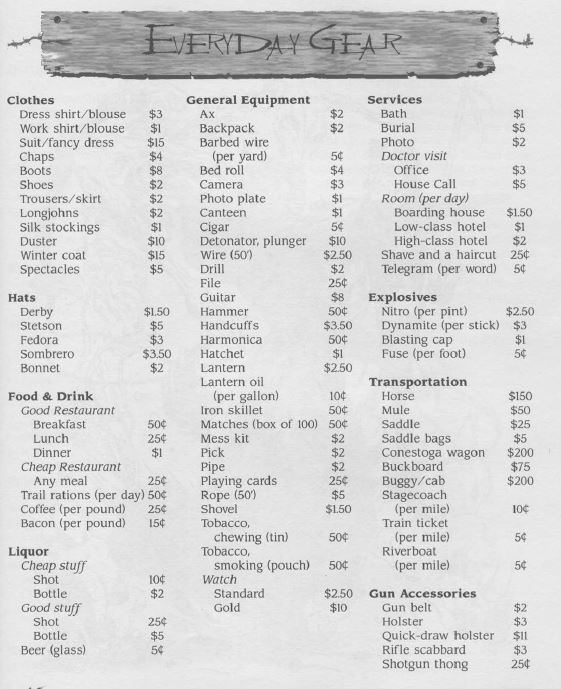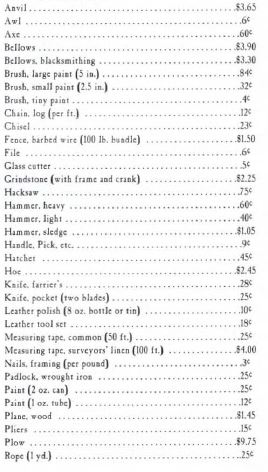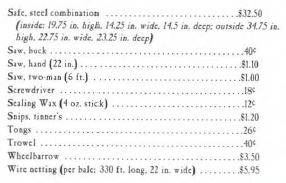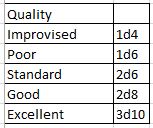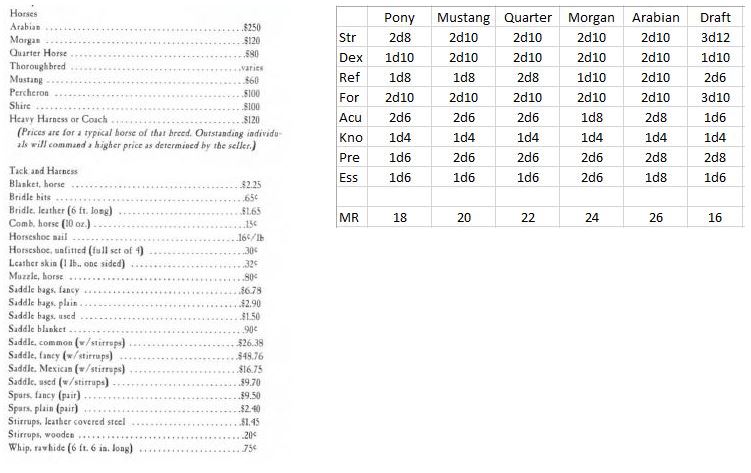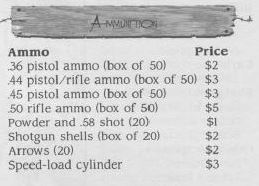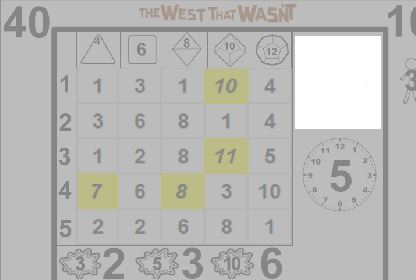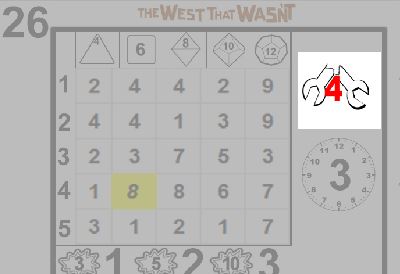Difference between revisions of "The West That Wasnt - Gear"
(→Other Attributes) |
|||
| Line 8: | Line 8: | ||
==Type Attributes== | ==Type Attributes== | ||
All items have an attribute that is related to the type of thing it is, such as a hammer is a tool, and therefore it has the tool attribute. These attributes are not all listed on the gear tables. Usually it is clear if a type attribute applies to a given item, but when it is not, the Judge has the final say. | All items have an attribute that is related to the type of thing it is, such as a hammer is a tool, and therefore it has the tool attribute. These attributes are not all listed on the gear tables. Usually it is clear if a type attribute applies to a given item, but when it is not, the Judge has the final say. | ||
| + | |||
| + | =Gear Lists= | ||
| + | The following gear price lists have been cribbed from other sources (some might say stolen). This is temporary. For now, the authors efforts are concentrated on game mechanics over setting elements like economy. Once we have everything else how we like it, we will spend some time developing our own lists. | ||
| + | |||
| + | In case you do not recognize them, the gear lists come from Deadlands 1st edition and Aces & Eights. Hey, at least we are attributing the sources! | ||
=Everyday Gear= | =Everyday Gear= | ||
| Line 112: | Line 117: | ||
==Muscle Powered Weapons== | ==Muscle Powered Weapons== | ||
[[image:archaic.JPG]] | [[image:archaic.JPG]] | ||
| + | |||
| + | =Equipment Reliability= | ||
| + | Every piece of equipment has a reliability (Rel) rating from 1-12, with lower numbers being more durable. The reliability section of the action card is above the clock face in the upper right hand portion of the card. | ||
| + | |||
| + | [[image:Reliability.JPG]] | ||
| + | |||
| + | On most cards, that section is blank, like this one. This means that no action is necessary. All equipment performs as expected. Some cards, however, have a broken wrench with an associated number. | ||
| + | |||
| + | [[image:Reliability-2.JPG]] | ||
| + | |||
| + | When this symbol appears, compare the reliability of the equipment to the number shown inside the broken wrench (in this case a 4). If the reliability of the equipment is higher than the number shown, the equipment fails. Check the toggle result, on a yes the equipment fails after completing the task, on a no it fails before. | ||
| + | |||
| + | If the equipment has a reliability of 1 an extra step must be taken. Immediately shuffle the entire deck, except this card, and cut. If the card cut shows the broken wrench with a 2, the equipment fails. Otherwise, it works properly. | ||
| + | |||
| + | ==Improvised Usage== | ||
| + | All of the above assumes that the equipment is being used as designed. When being used in a rough or unintended way equipment is more likely to fail. For new equipment, add 1 to the rel. For old and/or otherwise abused equipment, add 4. In all other cases add 2. Strange or extremely hazardous usage may bring an extra penalty to the Rel of +1-3 at Judges discretion. | ||
| + | |||
| + | ''Hank wants to smack an angry cowboy with a shovel. The shovel is in average condition, so the Judge adds 2 to the Rel, bringing it to 3.'' | ||
| + | |||
| + | Some uses are anticipated if not intended, such as hitting an adversary with the butt of a rifle or the handle of a pistol. These uses add 1 to the Rel unless the weapon is old or decrepit, in which case 2 is added. | ||
Revision as of 18:56, 4 April 2020
The following items are available in the West That Wasnt. These lists are not meant to be exhaustive, and have obviously been stolen from other sources just so we can get the playtesting underway. When this gets into a final state a new gear section will be created.
Contents
[hide]Using Gear
In most cases, to use an item it must be ready. Items are readied by performing an action. Readying an item might include taking a hammer from a toolbox, drawing a sidearm or even un-tethering a horse. Readying the item does not include any movement it takes to get to the item, but it does include any assembly if the item is normally stowed or carried unassembled. Readying an item costs between 1 and 4 APs depending on the size of the item.
Type Attributes
All items have an attribute that is related to the type of thing it is, such as a hammer is a tool, and therefore it has the tool attribute. These attributes are not all listed on the gear tables. Usually it is clear if a type attribute applies to a given item, but when it is not, the Judge has the final say.
Gear Lists
The following gear price lists have been cribbed from other sources (some might say stolen). This is temporary. For now, the authors efforts are concentrated on game mechanics over setting elements like economy. Once we have everything else how we like it, we will spend some time developing our own lists.
In case you do not recognize them, the gear lists come from Deadlands 1st edition and Aces & Eights. Hey, at least we are attributing the sources!
Everyday Gear
Tools
Tool Quality
Equipment is rated in quality from improvised to excellent. Improvised gear is equipment that has been made haphazardly or is being used in a way that it is not intended. For example, a rock or a stick may be used as a hammer, or even a shovel. They will work in a pinch, but are not good at the job. Poor quality tools are either old and worn out, or just shoddily made. The majority of tools are standard quality. Some items are of good quality, in general these cost 2-4x the listed price and are not available everywhere. The best items available are excellent quality, those produced by the finest craftsmen. They cost 10x the listed price.
Not all tools have the higher quality versions available. The simplest tools, such as hammers and shovels, can only be so good. Even the best versions do not produce better results, but instead are sturdier and last longer. Consult the Judge on whether a particular tool has higher quality options, and if they do, whether those items offer the increased efficacy, or only greater durability.
Mounts
Weapon Accessories
A speed load cylinder holds six rounds and can load all six in a single, 1 AP action. Reloading the cylinder is 1 AP for each round (as a normal reload).
Hand Weapons
Impact: Impact attacks deal only concussion. Their damage is added directly to the Strength damage of the character.
Throw: Weapon can be thrown. See muscle powered section under ranged weapons for statistics.
Defense: The number in parentheses is the number in parentheses is the number of advantage factors gained by the weapon when defending.
Pain: Concussion damage is doubled when determining result from Stun Save.
Short: Weapons with the short attribute receive +1 on any initiative based test, and also win initiative based ties versus non-short weapons.
Fistload: Character counts as armed versus unarmed foes or others using fistloads, unarmed versus others. Weapon deals Strength damage as well as weapon damage.
Thrown weapons may only use attributes listed on the muscle powered weapons table, below.
Ranged Weapons
All ranged weapons have an Aim value, which is the AP cost of the aim action, followed by a slash with a penalty listed for snap fire. The SPD value is the AP cost of the weapon (when cocked or ready, as applicable) followed by the AP cost of any cock action. Cock actions ready one barrel, if more than one barrel exists, additional cock actions are required.
Ranged Weapon Attributes
Ranged weapons come in numerous sizes and shapes, often with differing performance based on the attributes of the weapon. What follows are three types of attributes: shot, action and other. Shot attributes discuss how projectiles are delivered, propelled and contained. Action describes how the weapon is operated mechanically. Other attributes discuss anything else about the weapon that is noteworthy in game play.
Shot Attributes
Cartridge: Cartridges are self contained bullet and powder in a single unit. Loading most cartridge weapons is a 1 AP action for each cartridge and speed loading is possible. Single action pistols cost 2 AP to start reloading unless they have the Top Break attribute. Some cartridge rifles also have longer reload speeds, and are notated in the attributes.
Muzzle Loader: Muzzle loading weapons require loose powder, ball and percussion cap. Muzzle loading a shotgun is a 10 AP action. If the weapon has multiple barrels, an attempt may be made to load both simultaneously. This requires a Dexterity check at TN 7. Success indicates both are loaded, failure indicates neither are loaded, but both will be successfully loaded next round with no check required. On a CF result, neither barrel is loaded and at least one required item is lost (one shot is spent). Performing a muzzle load on a rifle or musket requires 20 AP to complete. Muzzle loading weapons require 1 AP to cock, which can be performed simultaneously with the loading if desired. Muzzle loading weapons cannot be speed loaded.
Percussion: Cap and ball revolvers require a percussion cap, loose black powder and a lead bullet (ball) to load. Loading a Percussion handgun requires 7 AP. One cylinder can be loaded on a 3 TN Dexterity check, two cylinders on a 7. The chamber fails to load on a failure, but can be attempted again next round with no penalty. On a CF result, the chamber is not loaded and at least one required item is lost (the round is spent).
Action Attributes
Breech Load: Breech loading rifles and shotguns are 2 AP to fire when cocked, but require a 1 AP action to cock. Breech loading rifles can load a single cartridge for 1 AP, and can be speed loaded. Breech loading shotguns can load a single cartridge for 1 AP, and can be speed loaded.
Double Action: Double action revolvers are 1 AP actions to fire, and do not need to be cocked. A 1 AP action may be used to cock a double action revolver, if desired. Double action revolvers suffer a +1 to TN to all targets beyond close, if not cocked, because of the heavier trigger pull.
Hammerless: Hammerless shotguns to not need to be cocked to fire.
Lever Action: Lever action rifles are 2 AP to fire when cocked. They require a 1 AP action to cock. Lever action rifles require a 2 AP to load the first round, but can load subsequent cartridges for 1 AP each. All but the first cartridge can be speed loaded.
Single Action: Single action revolvers are 1 AP when cocked, and require a 1 AP to cock. Single action pistols cost 2 AP per round to reload unless they have the Top Break or Percussion attribute. Single Action revolvers win initiative based ties versus other firearms.
Top Break: Top Break revolvers have a release latch that allows the barrel to draw down and eject spent cartridges, speeding reload time immensely. Top Break revolvers are 1 AP to reload each chamber, and can be speed loaded.
Trapdoor: Trapdoor rifles are similar to breech loading rifles, but instead of pushing the cartridge into the barrel from behind, it is dropped into the action from above. The trapdoor can be opened and reloaded for 2 AP, and cannot be speed loaded. They require 2 AP to cock.
Other Attributes
2x: Weapons with the 2x attribute may fire both barrels simultaneously. When firing both barrels, add the RD to the DMG on P results, and double the RD on A results.
Accurate: Accurate weapons receive the number in parentheses as a bonus to their shooting result if the shot follows an Aim action (not the initial aim to remove the penalty).
Fan Fire: A single action revolver is capable of fan firing. When using the fan fire action, the speed 1 AP per shot, and the Fan Firing rules apply.
Fistload: The character counts as armed versus unarmed characters or other characters using Fistloads. Otherwise, the character is unarmed.
Inaccurate: The short barrel of this weapon makes it harder to find a target. Aimed shots suffer a -1 penalty.
Long: Long weapons increase the TN of any fast draw attempt by the number in parentheses. Additionally, they suffer an initiative resolution penalty equal to the number in parentheses.
Muscle: Weapons with the muscle attribute cost 2 AP to use when ready/loaded, and load/ready for 2 AP. The character adds their DB to any damage done by the weapon.
Quick: Weapons with the quick attribute may reload/ready for 1 AP with a successful Speed Load check.
Scatter: Weapons with the scatter attribute always produce stray shots (see unintended targets, conflict section). Add one to the number of stray shots per range increment. Also, decrement the die type and penetration every two range increments. If a target is hit because of this rule, treat P results as A, and A results as D. Unarmored targets are treated as an A result.
Short: Weapons with the short attribute reduce the TN by 1 in any fast draw attempt.
Handguns
All handguns have the Fast attribute.
Colt Lightning
The 1877 Colt Lightning was the first double action Colt revolver. Like other double action revolvers, it can be cocked first and used like a single action. However, unlike later double action revolvers, it has the same loading mechanism of the single action army (the Peacemaker). It acts as a single action for reload purposes. The larger caliber version, the .41 listed here, is usually called the "Thunderer".
Rifles
Shotguns
All shotguns have the Long (1) attribute. They can be "sawed off" to either a normal length (no attribute) or Short. Reduce the range by 3 for each level of sawed off.
Muscle Powered Weapons
Equipment Reliability
Every piece of equipment has a reliability (Rel) rating from 1-12, with lower numbers being more durable. The reliability section of the action card is above the clock face in the upper right hand portion of the card.
On most cards, that section is blank, like this one. This means that no action is necessary. All equipment performs as expected. Some cards, however, have a broken wrench with an associated number.
When this symbol appears, compare the reliability of the equipment to the number shown inside the broken wrench (in this case a 4). If the reliability of the equipment is higher than the number shown, the equipment fails. Check the toggle result, on a yes the equipment fails after completing the task, on a no it fails before.
If the equipment has a reliability of 1 an extra step must be taken. Immediately shuffle the entire deck, except this card, and cut. If the card cut shows the broken wrench with a 2, the equipment fails. Otherwise, it works properly.
Improvised Usage
All of the above assumes that the equipment is being used as designed. When being used in a rough or unintended way equipment is more likely to fail. For new equipment, add 1 to the rel. For old and/or otherwise abused equipment, add 4. In all other cases add 2. Strange or extremely hazardous usage may bring an extra penalty to the Rel of +1-3 at Judges discretion.
Hank wants to smack an angry cowboy with a shovel. The shovel is in average condition, so the Judge adds 2 to the Rel, bringing it to 3.
Some uses are anticipated if not intended, such as hitting an adversary with the butt of a rifle or the handle of a pistol. These uses add 1 to the Rel unless the weapon is old or decrepit, in which case 2 is added.
